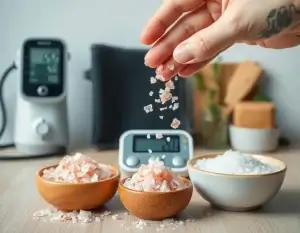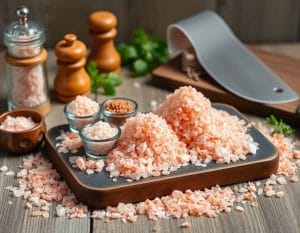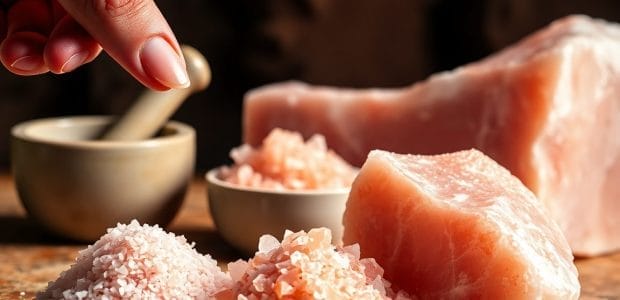When you browse health food stores or scroll through wellness influencer content, you’ve likely encountered those aesthetically pleasing pink crystals marketed as a miracle mineral source. But between the premium price tag and extraordinary health claims, a crucial question emerges: Does Pink Himalayan salt actually provide real health benefits, or are we simply paying more for pretty pink crystals?
This comprehensive analysis examines the scientific evidence behind Pink Himalayan salt’s reputation, separating documented facts from wishful thinking. We’ll explore what recent research reveals about its mineral composition, health effects, and how it truly compares to regular table salt when it comes to your wellbeing.
The Geological Origins: What Makes It Pink?
Understanding Pink Himalayan salt begins with its fascinating geological history and distinctive characteristics.
Formation and Harvesting Process
Pink Himalayan salt comes primarily from the Khewra Salt Mine in Pakistan, located approximately 300 kilometers from the actual Himalayan mountains. This ancient salt deposit formed roughly 250 million years ago when prehistoric seas evaporated, leaving vast crystallized salt beds that were subsequently buried by tectonic activity.
The extraction process typically involves traditional mining methods:
- Hand-extraction using minimal machinery
- Stone grinding rather than industrial processing
- Minimal chemical treatment compared to table salt
These less industrialized methods contribute to its reputation as a “natural” product, though they also increase production costs significantly.
The Science Behind Its Distinctive Color
The salt’s signature pink-to-reddish hue comes from specific mineral impurities:
- Iron oxide (rust) provides the primary pink coloration
- Trace amounts of magnesium contribute subtle color variations
- Manganese and other minerals create occasional darker streaks
While these compounds create an appealing appearance, their presence raises an important question: Do these trace minerals actually translate to meaningful health benefits?

Compositional Analysis: What’s Actually In It?
Marketing materials often highlight Pink Himalayan salt’s “84 trace minerals” and “unique mineral profile.” But what does scientific analysis actually reveal about its composition?
Primary Mineral Makeup
Laboratory analyses consistently show that Pink Himalayan salt consists of:
- Sodium chloride: 98% (identical to table salt)
- All other minerals and elements combined: approximately 2%
This composition is crucial to understand because it immediately reveals a fundamental truth: Pink Himalayan salt is overwhelmingly sodium chloride—the same compound that makes up ordinary table salt.
Trace Mineral Reality Check
Within that 2% non-sodium chloride content, independent laboratory testing has identified various minerals and elements including:
| Mineral | Approximate Amount | % of Daily Value |
|---|---|---|
| Potassium | 0.28% | <0.01% per serving |
| Magnesium | 0.16% | <0.01% per serving |
| Calcium | 0.16% | <0.01% per serving |
| Iron | 0.0004% | <0.01% per serving |
As shown in the table above, these trace minerals appear in such minute quantities that you would need to consume dangerous amounts of salt to receive any nutritional benefit from them. For perspective, you would need to consume approximately 6 pounds of Pink Himalayan salt to get a meaningful amount of calcium—clearly an impossible and dangerous amount.
Problematic Elements Present
Less discussed in marketing materials are potentially concerning elements that sometimes appear in Pink Himalayan salt:
- Lead: Some samples exceed acceptable levels according to Australian research (2020)
- Aluminum: Present in trace amounts
- Uranium and radium: Yes, radioactive elements are among the “natural minerals” present
While these elements typically appear in non-toxic concentrations, their presence contradicts the “pure and pristine” marketing narrative often associated with the product.
Comparing Pink Himalayan Salt to Table Salt: Meaningful Differences?
One of the most important questions is whether Pink Himalayan salt offers any genuine advantages over common table salt when it comes to health impact.
Sodium Content Comparison
From a health perspective, sodium content matters most, as excessive sodium intake is linked to hypertension and cardiovascular problems:
- Pink Himalayan salt: 2200-2300mg sodium per teaspoon
- Standard table salt: 2300mg sodium per teaspoon
As these figures demonstrate, both varieties contain virtually identical amounts of sodium, the primary mineral of health concern. This means Pink Himalayan salt poses the same cardiovascular risks as regular salt when consumed in excess.
Processing and Additives
One legitimate difference between these salt varieties involves processing methods:
- Table salt typically undergoes more extensive processing and often contains anti-caking agents like calcium silicate to prevent clumping
- Pink Himalayan salt generally undergoes minimal processing and rarely contains additional ingredients
For consumers concerned about food additives, this difference may be meaningful. However, anti-caking agents in table salt are FDA-approved and present in minute quantities generally recognized as safe.
The Iodine Factor
A significant nutritional difference often overlooked in Pink Himalayan salt marketing:
- Table salt is commonly fortified with iodine, an essential nutrient that helps prevent thyroid disorders
- Pink Himalayan salt lacks iodine fortification in most cases
This distinction represents a potential disadvantage for Pink Himalayan salt, as iodine deficiency can lead to serious health problems including goiter and hypothyroidism. The iodization of table salt has been a public health success story, dramatically reducing iodine deficiency disorders worldwide.

Examining Popular Health Claims: What Science Says
Pink Himalayan salt has been credited with numerous health benefits. Let’s examine how these claims hold up against scientific evidence.
Improved Mineral Intake
Claim: Pink Himalayan salt provides essential minerals lacking in regular salt.
Evidence: As detailed earlier, while additional minerals are present, their quantities are nutritionally insignificant. Nutritionists from Johns Hopkins Medicine and other institutions confirm you would need to consume toxic amounts of salt to obtain meaningful mineral benefits from these trace elements.
Verdict: Misleading claim with minimal scientific support.
Detoxification Benefits
Claim: Pink Himalayan salt helps remove toxins from the body.
Evidence: No credible scientific studies support the notion that Pink Himalayan salt—or any salt variety—assists with the body’s natural detoxification processes. Your liver and kidneys handle detoxification without requiring specific salt types.
Verdict: Unsupported claim without scientific backing.
Respiratory Health Improvement
Claim: Salt lamps and inhalers made from Pink Himalayan salt improve air quality and respiratory health.
Evidence: Scientific research has found minimal evidence supporting respiratory benefits from these products. A 2022 review of available studies concluded that perceived benefits likely result from placebo effects rather than physiological changes.
Verdict: Insufficient evidence to support this claim.
Blood Pressure Regulation
Claim: Pink Himalayan salt is better for blood pressure than regular salt.
Evidence: This claim contradicts basic nutritional science. Both salt varieties contain similar sodium levels, and excessive sodium intake from any source can contribute to hypertension in salt-sensitive individuals.
Verdict: Potentially harmful misinformation that contradicts medical consensus.
Appropriate Uses for Pink Himalayan Salt
Despite the lack of substantiated health advantages, Pink Himalayan salt does have legitimate culinary applications based on its physical properties and aesthetic appeal.
Culinary Applications Where It Shines
Pink Himalayan salt can enhance the cooking experience in several ways:
- As a finishing salt: Its coarse texture and visual appeal make it excellent for final seasoning of prepared dishes
- For salt rims on cocktails: The pink color adds an attractive decorative element
- Salt blocks for cooking: These can impart subtle mineral flavors while serving as conversation pieces
- In homemade seasoning blends: The color creates visually distinctive spice mixtures
These applications leverage the salt’s genuine attributes—appearance, texture, and flavor—rather than unsubstantiated health claims.
Sensible Consumption Guidelines
If you choose to use Pink Himalayan salt, follow these evidence-based recommendations:
- Adhere to general sodium guidelines: Limit total sodium intake to 2300mg daily (approximately one teaspoon of any salt)
- Balance intake: Incorporate potassium-rich foods like bananas and leafy greens to help offset sodium’s effects
- Consider dietary needs: If you exclusively use Pink Himalayan salt, ensure you’re getting iodine from other sources like seafood or supplements
- Use purposefully: Employ it where its visual and textural properties enhance the culinary experience rather than as a health supplement
Consumer Perspective: Is It Worth the Premium Price?
Pink Himalayan salt typically costs $5-15 per kilogram compared to approximately $1 per kilogram for regular table salt. Is this price difference justified?
Value Assessment Factors
Your decision might depend on these considerations:
- Culinary focus: The aesthetic and textural benefits may justify the cost for specific culinary applications
- Health priorities: If making purchasing decisions based on health benefits, the premium price lacks scientific justification
- Additive concerns: For those strictly avoiding all food additives, the minimal processing may warrant the additional cost
- Iodine needs: Consider whether you’re getting sufficient iodine from other dietary sources if choosing non-iodized salt
Market Analysis
The premium positioning appears driven by perception rather than production necessity:
- Global Pink Himalayan salt market: Valued at approximately $470 million in 2023
- Growth projection: 5.7% CAGR through 2030
- Price premium: 400-1500% over conventional salt
These figures suggest successful marketing rather than production costs drives the price differential, as the actual extraction and transportation costs don’t fully explain the substantial markup.
The Verdict: Making an Informed Decision
After examining the scientific evidence surrounding Pink Himalayan salt, several conclusions emerge:
- No significant health advantages: Scientific evidence does not support claims of meaningful health benefits compared to regular salt
- Identical sodium concerns: It contains similar sodium levels to table salt and therefore poses the same health risks when consumed excessively
- Trace minerals in insignificant amounts: The additional minerals present exist in quantities too small to impact nutritional status
- Lacking iodine fortification: Unlike many table salts, it typically doesn’t contain added iodine, a potential nutritional disadvantage
- Legitimate culinary applications: Its texture, appearance, and taste may justify its use for specific cooking purposes
The bottom line: Pink Himalayan salt is primarily a premium culinary product distinguished by aesthetics rather than health benefits. Purchase decisions should be based on culinary preferences and budget considerations rather than expected health outcomes.
What has been your experience with Pink Himalayan salt? Share your thoughts in the comments below!

